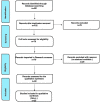One year of anatomy teaching and learning in the outbreak: Has the Covid-19 pandemic marked the end of a century-old practice? A systematic review
- PMID: 34890477
- PMCID: PMC9011560
- DOI: 10.1002/ase.2162
One year of anatomy teaching and learning in the outbreak: Has the Covid-19 pandemic marked the end of a century-old practice? A systematic review
Abstract
At the end of 2019, the Covid-19 pandemic spread caused restrictions in business and social spheres. Higher education was also severely affected: universities and medical schools moved online to distance learning and laboratory facilities closed. Questions arise about the long-term effects of this pandemic on anatomical education. In this systematic review, the authors investigated whether or not anatomical educators were able to deliver anatomical knowledge during this pandemic. They also discuss the challenges that anatomical education has faced over the last year. The search strategy was conducted between July 2020 and July 2021. Two hundred and one records were identified, and a total of 79 studies were finally included. How best to deliver anatomy to students remains a moot point. In the last years, the advent of new technologies has raised the question of the possible overcoming of dissection as the main instrument in anatomical education. The Covid-19 pandemic further sharpened the debate. Remote learning enhanced the use of technologies other than cadaveric dissection to teach anatomy. Moreover, from the analyzed records it appears that both from students' perspective as well as teachers' there is a clear tear between those who endorse dissection and those who believe it could be easily overcome or at least integrated by virtual reality and online learning. The authors strongly believe that the best anatomy teaching practice requires the careful adaptation of resources and methods. Nevertheless, they support cadaveric dissection and hope that it will not be replaced entirely as a result of this pandemic.
Keywords: Covid-19; anatomy laboratories; body donation; cadaveric dissection; gross anatomy education; infectious diseases; medical education; pandemic.
© 2021 American Association for Anatomy.
Conflict of interest statement
None of the authors have a conflict of interest to declare.
Figures


Similar articles
-
Is cadaveric dissection essential in medical education? A qualitative survey comparing pre-and post-COVID-19 anatomy courses.J Osteopath Med. 2022 Aug 30;123(1):19-26. doi: 10.1515/jom-2022-0016. eCollection 2023 Jan 1. J Osteopath Med. 2022. PMID: 36039567
-
Technological resources for teaching and learning about human anatomy in the medical course: Systematic review of literature.Anat Sci Educ. 2022 Mar;15(2):403-419. doi: 10.1002/ase.2142. Epub 2021 Dec 1. Anat Sci Educ. 2022. PMID: 34664384
-
Rapid, point-of-care antigen tests for diagnosis of SARS-CoV-2 infection.Cochrane Database Syst Rev. 2022 Jul 22;7(7):CD013705. doi: 10.1002/14651858.CD013705.pub3. Cochrane Database Syst Rev. 2022. PMID: 35866452 Free PMC article.
-
Measures implemented in the school setting to contain the COVID-19 pandemic.Cochrane Database Syst Rev. 2022 Jan 17;1(1):CD015029. doi: 10.1002/14651858.CD015029. Cochrane Database Syst Rev. 2022. Update in: Cochrane Database Syst Rev. 2024 May 2;5:CD015029. doi: 10.1002/14651858.CD015029.pub2. PMID: 35037252 Free PMC article. Updated.
-
Achievement of learning outcomes in non-traditional (online) versus traditional (face-to-face) anatomy teaching in medical schools: A mixed method systematic review.Clin Anat. 2023 Jan;36(1):50-76. doi: 10.1002/ca.23942. Epub 2022 Aug 25. Clin Anat. 2023. PMID: 35969356 Free PMC article.
Cited by
-
Anatomical Ignorance Resulting in Iatrogenic Causes of Human Morbidity.Cureus. 2024 Mar 19;16(3):e56480. doi: 10.7759/cureus.56480. eCollection 2024 Mar. Cureus. 2024. PMID: 38638713 Free PMC article. Review.
-
Peripheral Brain Access in Small Group Discussion in Anatomy.Acta Med Philipp. 2023 Oct 26;57(10):39-44. doi: 10.47895/amp.v57i10.7045. eCollection 2023. Acta Med Philipp. 2023. PMID: 39483183 Free PMC article.
-
Insights of Medical Students and Graduates Toward Electronic Learning During the COVID-19 Pandemic in Lebanon: A National Cross-Sectional Study.J Med Educ Curric Dev. 2023 Oct 19;10:23821205231209106. doi: 10.1177/23821205231209106. eCollection 2023 Jan-Dec. J Med Educ Curric Dev. 2023. PMID: 37868043 Free PMC article.
-
Assessment of Factors That Students Perceive to Affect Their Virtual Learning of Clinical Skills for OSCE.Adv Med Educ Pract. 2023 Jul 7;14:707-712. doi: 10.2147/AMEP.S402920. eCollection 2023. Adv Med Educ Pract. 2023. PMID: 37440771 Free PMC article.
-
Human cerebral blood supply via circulus arteriosus cerebri: A scoping review on its variations and clinical implications.Heliyon. 2024 Jun 8;10(12):e32648. doi: 10.1016/j.heliyon.2024.e32648. eCollection 2024 Jun 30. Heliyon. 2024. PMID: 38975214 Free PMC article.
References
-
- Alsharif MH, Gasmalla HE, Elamin Y, Almasaad JM, Elhag AE. 2020. In Light of COVID‐19 crisis: Proposed guidelines. Med Sci 24:3281–3290.
-
- Balta JY, Cronin M, Cryan JF, O’Mahony SM. 2015a. Human preservation techniques in anatomy: A 21st century medical education perspective. Clin Anat 28:725–734. - PubMed
-
- Balta JY, Lamb C, Soames RW. 2015b. A pilot study comparing the use of Thiel‐ and formalin‐embalmed cadavers in the teaching of human anatomy. Anat Sci Educ 8:86–91. - PubMed
Publication types
MeSH terms
LinkOut - more resources
Full Text Sources
Medical

